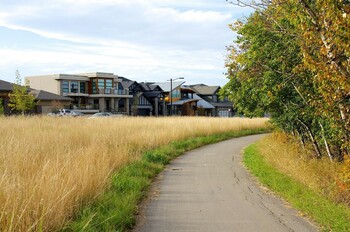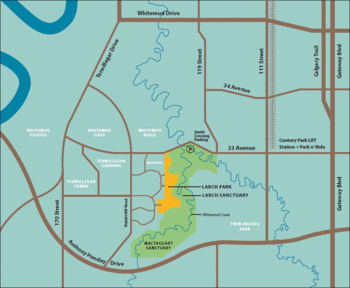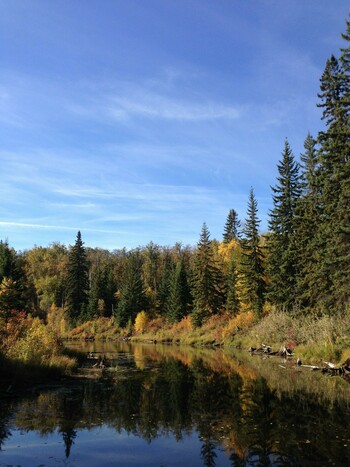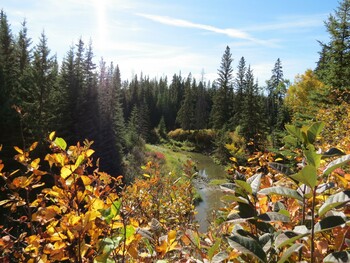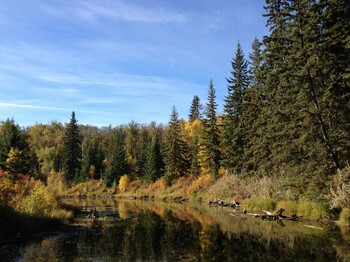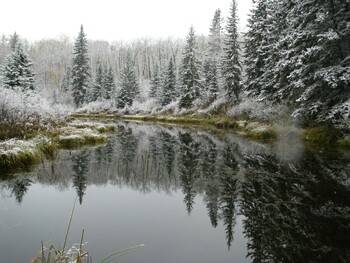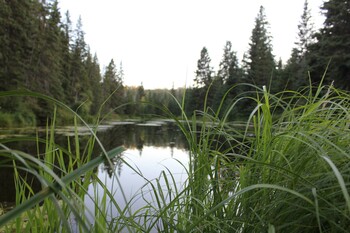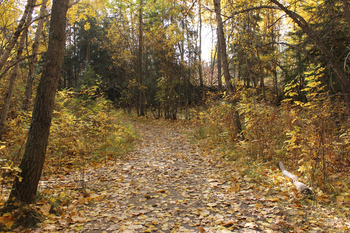Conservation Easement & NBS in Residential Development: Edmonton
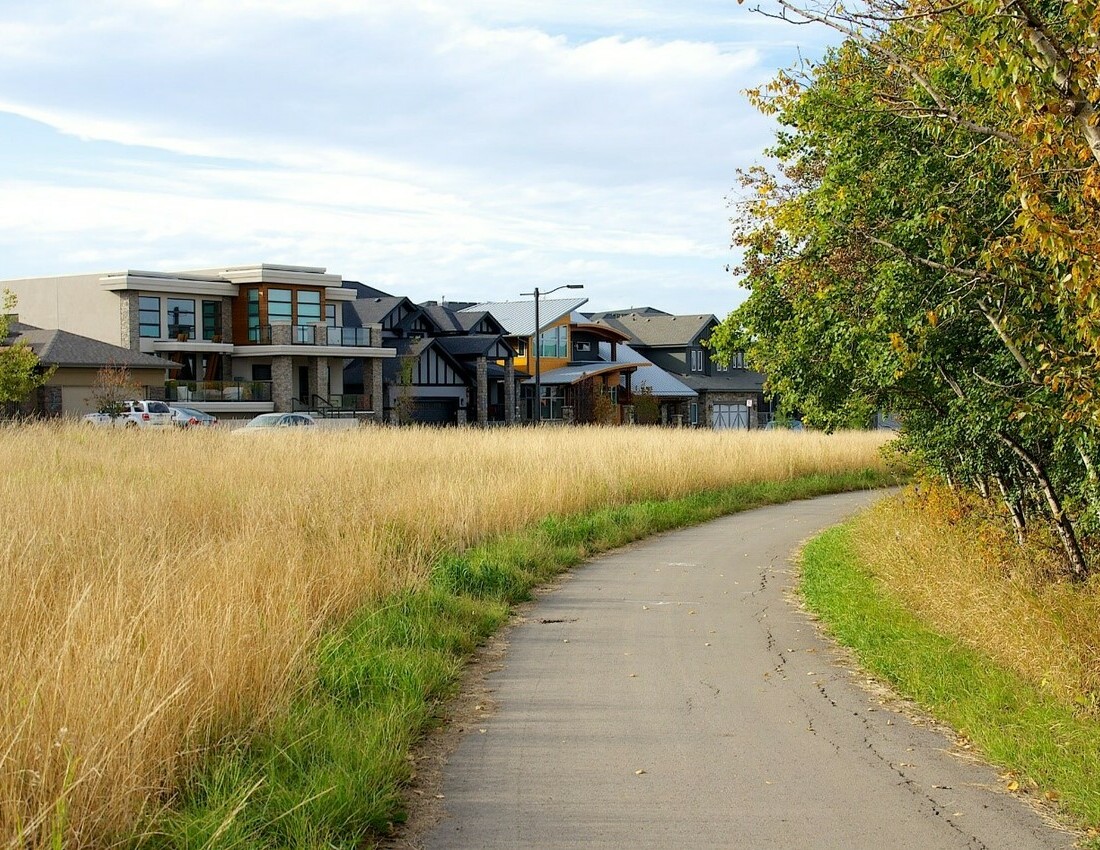
Overview
Larch Park is a residential development adjacent to the Larch Sanctuary in southwest Edmonton. The development was designed to include a variety of dwellings and incorporates several nature-based solutions (NBS) to minimize its impacts on the neighbouring nature preserve. It includes a naturalized stormwater wetland, native species-planted boulevards, bioswales, interpretive signs, a community garden and a walkable neighbourhood of green buildings. The developer worked with the City of Edmonton and the Edmonton & Area Land Trust (EALT) to designate the area beside Larch Park as a conservation easement.
Larch Sanctuary was the first conservation easement secured by EALT within the City and the first conservation easement in Edmonton. It was finalized in 2017. This prime example of NBS at work in an urban centre protects a 59-acre parcel of wilderness along a tributary of the North Saskatchewan River in perpetuity. The land is owned by the City and stewarded by EALT through their invasive plant removal, water quality testing, advocacy and educational work.
Objectives
The previous owner of the land on which Larch Sanctuary and Larch Park are situated wanted to sell it to a developer that would focus on the natural elements and sustainability of the entire property. When the developer, Melcor, applied to the City for subdivision approval, the area now known as Larch Sanctuary became an environmental reserve. Melcor planned the Larch Park development with ecological integrity in mind and worked with EALT to negotiate the subsequent conservation easement with the City after Larch Park was developed.
The conservation easement on Larch Sanctuary was established to protect a wildlife corridor and a stretch of Whitemud Creek, a tributary of the North Saskatchewan River. By designating this unique ecological site as a nature sanctuary, an oxbow lake has been conserved. Just past the boundary of the easement lies the confluence of Blackmud Creek and Whitemud Creek and downstream parkland of the Whitemud Creek Ravine.
Project Planning
Melcor is committed to building great communities for Edmontonians, and their upfront investment in time and costs to develop Larch Park with sustainability as a major focus paid off in the long run. Significant study and research was undertaken to enhance the land’s natural features, including the naturalized stormwater wetland. Melcor also engaged the University of Alberta for technical expertise.
For developers to successfully implement NBS, municipalities need to adapt to be able to approve these interventions and subsequently take over maintenance of sustainable infrastructure when projects are complete. This requires municipalities to be flexible and take some risks to support developers in including low-impact development and NBS in projects.
Development plans in Larch Park and the completion of the naturalized stormwater wetland – one of the first in the City – and other environmental features had already been completed prior to the conservation easement being placed on Larch Sanctuary. It took nine years to plan and finalize the conservation easement. EALT secured this added level of protection on the City’s land and Melcor assisted with negotiations between the two.
The Alberta Stewardship Act guided the planning process for establishing the conservation easement on Larch Sanctuary. The City of Edmonton’s Bylaw 17502, Registration of Conservation was used by City Council to approve the conservation easement. In order for the conservation easement to be registered, an amendment to the Municipal Government Act was also required.
It took time and considerable effort, but the resulting conservation easement ensures conservation and stewardship efforts remain in effect in perpetuity.
The Business Side
Larch Park did cost more than a conventional residential development without NBS. However, Melcor was able to recover those costs and Larch Park is considered a desirable residential area because of its innovative features that have increased climate resiliency, enhanced aesthetics and improved community liveability.
Larch Sanctuary exemplifies green heritage and local stewardship business models associated with NBS, while Larch Park aligns with the green densification business model. Establishing a conservation easement costs money; EALT paid for lawyer’s fees, staff time, site visits, etc. and funds from an endowment from the original owner and Melcor provide some funding for the ongoing stewardship of the site by the land trust. EALT currently monitors, manages weeds, engages in communications and outreach and is working with the City on interpretive signage and maps for the site. As the owner of the site, the City of Edmonton is still responsible for some of the maintenance.
The Nature Side
The preservation of Larch’s mature forest with unique features, such as the oxbow lake, has great benefits for local biodiversity and wildlife connectivity. The Sanctuary provides habitat for many species of birds, waterfowl, aquatic and terrestrial animals. The site also features bat boxes and a bee hotel. Protecting the slopes near the creek and oxbow lake by restricting development along the creek’s banks also helps to ensure water quality and mitigate the impacts of floods. The forest of Larch Sanctuary is also a valuable carbon sink, sequestering greenhouse gases from the atmosphere.
NBS initiatives in Larch Park also provide many environmental benefits and help to protect the Larch Sanctuary. The bioswale and stormwater wetland act to mitigate floods and to improve water quality. Green spaces planted with native species and the community gardens add to local biodiversity and carbon sequestration.
The Community Side
Residents and visitors to Edmonton can enjoy the beautiful forest of Larch Sanctuary within the city. Access to nature has been shown to have multiple benefits to human physical and mental health. There are walking trails for recreational use and wildlife viewing. Protecting this land along a tributary of the North Saskatchewan River also helps maintain water quality for the City.
Since NBS were included in the development of Larch Park, people living there enjoy the benefits of the local greenspace, naturalized stormwater wetland and community garden. These benefits include improvements in human health, social cohesion, flood attenuation and real estate marketability.
Photo Credits:
Images 1-3 courtesy of Melcor Developments Ltd.
Images 4-9 courtesy of Edmonton & Area Land Trust
